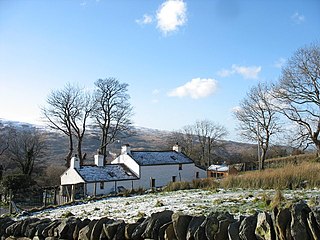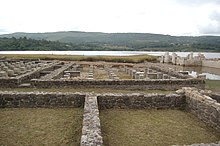Endovelicus is the best known of the pre-Roman Lusitanian and Celtiberian gods of the Iron Age. He was originally a chthonic god. He was the God/Lord of the Underworld and of health, prophecy and the earth, associated with vegetation and the afterlife. Later accepted by the Romans themselves, who assimilated it to Pluto or to Serapis and made him a relatively popular god.

Lugus is a god of the Celtic pantheon. His name is rarely directly attested in inscriptions, but his importance can be inferred from place names and ethnonyms and status as king of the gods. His nature and attributes are deduced from the distinctive iconography of Gallo-Roman inscriptions to Mercury, who is widely believed to have been identified with Lugus, and from the quasi-mythological narratives involving his later cognates, Welsh Lleu Llaw Gyffes and Irish Lugh Lámhfhada.

In Celtic mythology, Taranis is the god of thunder, who was worshipped primarily in Gaul, Hispania, Britain, and Ireland, but also in the Rhineland and Danube regions, amongst others. Taranis, along with Esus and Toutatis, was mentioned by the Roman poet Lucan in his epic poem Pharsalia as a Celtic deity to whom human sacrificial offerings were made. Taranis was associated, as was the Cyclops Brontes ("thunder") in Greek mythology, with the wheel.

Venetic is an extinct Indo-European language, usually classified into the Italic subgroup, that was spoken by the Veneti people in ancient times in northeast Italy and part of modern Slovenia, between the Po Delta and the southern fringe of the Alps, associated with the Este culture.

Ataegina was a goddess worshipped by the ancient Iberians, Lusitanians, and Celtiberians of the Iberian Peninsula. She is believed to have ruled the underworld.
Trebaruna, also Treborunnis and possibly *Trebarunu, was a Lusitanian deity, probably a goddess. Trebaruna's cult was located in the cultural area of Gallaecia and Lusitania.
In ancient Celtic religion, Sulevia was a goddess worshipped in Gaul, Britain, and Galicia, very often in the plural forms Suleviae or (dative) Sule(v)is. Dedications to Sulevia(e) are attested in about forty inscriptions, distributed quite widely in the Celtic world, but with particular concentrations in Noricum, among the Helvetii, along the Rhine, and also in Rome. Jufer and Luginbühl distinguish the Suleviae from another group of plural Celtic goddesses, the Matres, and interpret the name Suleviae as meaning "those who govern well". In the same vein, Patrizia de Bernardo Stempel connects Suleviae with Welsh hylyw 'leading (well)' and Breton helevez 'good behaviour'.

Celtiberian or Northeastern Hispano-Celtic is an extinct Indo-European language of the Celtic branch spoken by the Celtiberians in an area of the Iberian Peninsula between the headwaters of the Douro, Tagus, Júcar and Turia rivers and the Ebro river. This language is directly attested in nearly 200 inscriptions dated to the 2nd and 1st centuries BC, mainly in Celtiberian script, a direct adaptation of the northeastern Iberian script, but also in the Latin alphabet. The longest extant Celtiberian inscriptions are those on three Botorrita plaques, bronze plaques from Botorrita near Zaragoza, dating to the early 1st century BC, labeled Botorrita I, III and IV.

The Botorrita plaques are four bronze plaques discovered in Botorrita, near Zaragoza, Spain, dating to the late 2nd century BC, known as Botorrita I, II, III and IV.

Lusitanian was an Indo-European Paleohispanic language. There has been support for either a connection with the ancient Italic languages or Celtic languages. It is known from only six sizeable inscriptions, dated from circa 1 CE, and numerous names of places (toponyms) and of gods (theonyms). The language was spoken in the territory inhabited by Lusitanian tribes, from the Douro to the Tagus rivers, territory that today falls in central Portugal and western Spain.

The Aquitanian language was the language of the ancient Aquitani, spoken on both sides of the western Pyrenees in ancient Aquitaine and in the areas south of the Pyrenees in the valleys of the Basque Country before the Roman conquest. It probably survived in Aquitania north of the Pyrenees until the Early Middle Ages.
Teutamus was a Macedonian officer, who, in 319 BC, shared with Antigenes the command of the select troops called the Argyraspids.

Dinorwig, sometimes spelled Dinorwic, is a village located high above Llyn Padarn, near Llanberis, in Wales. The name is shared with the fort of Dinas Dinorwig, also within the community of Llanddeiniolen, on a foothill 6 kilometres (3.7 mi) from Dinorwig village and 3 kilometres (1.9 mi) from the Menai Strait and also with Port Dinorwic, the anglicised name of Y Felinheli.
Latobius was a sky and mountain Celtic god worshipped by the people of Noricum. During ancient Roman times he was equated with aspects of Jupiter and Mars. Votive inscriptions for Mars Latobius are typically found on mountain tops and on passes in former Noricum.
Litavis is a Gallic deity whose cult is primarily attested in east-central Gaul during the Roman period. She was probably originally an earth-goddess. In medieval Celtic languages, various terms derived from *Litauia came to designate the Brittany Peninsula.
Bandua was a theonym used to refer to a god or goddess worshipped in Iberia by Gallaeci and Lusitanians. Whether the name referred to a discrete deity or was an epithet applied to different deities is arguable.
Toutatis or Teutates is a Celtic god who was worshipped primarily in ancient Gaul and Britain. His name means "god of the tribe", and he has been widely interpreted as a tribal protector. According to Roman writer Lucan, the Gauls offered human sacrifices to him.
Trebopala is a Lusitanian name usually interpreted as a theonym, appearing on the Cabeço das Fraguas inscription from Portugal. Trebopala is probably a goddess.

The Larzac tablet is a lead curse tablet found in 1983 in the commune of L'Hospitalet-du-Larzac, Aveyron, southern France. It is now kept in the museum of Millau. It bears one of the most important inscriptions in the Gaulish language.
The Arecomici or Volcae Arecomici were a Gallic tribe dwelling between the Rhône and the Hérault rivers, around present-day Nîmes, during the Iron Age and the Roman period.










